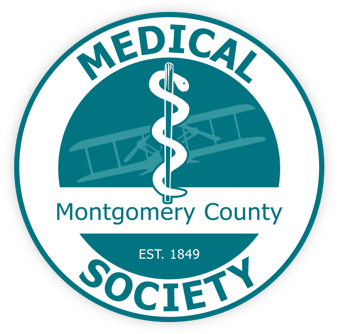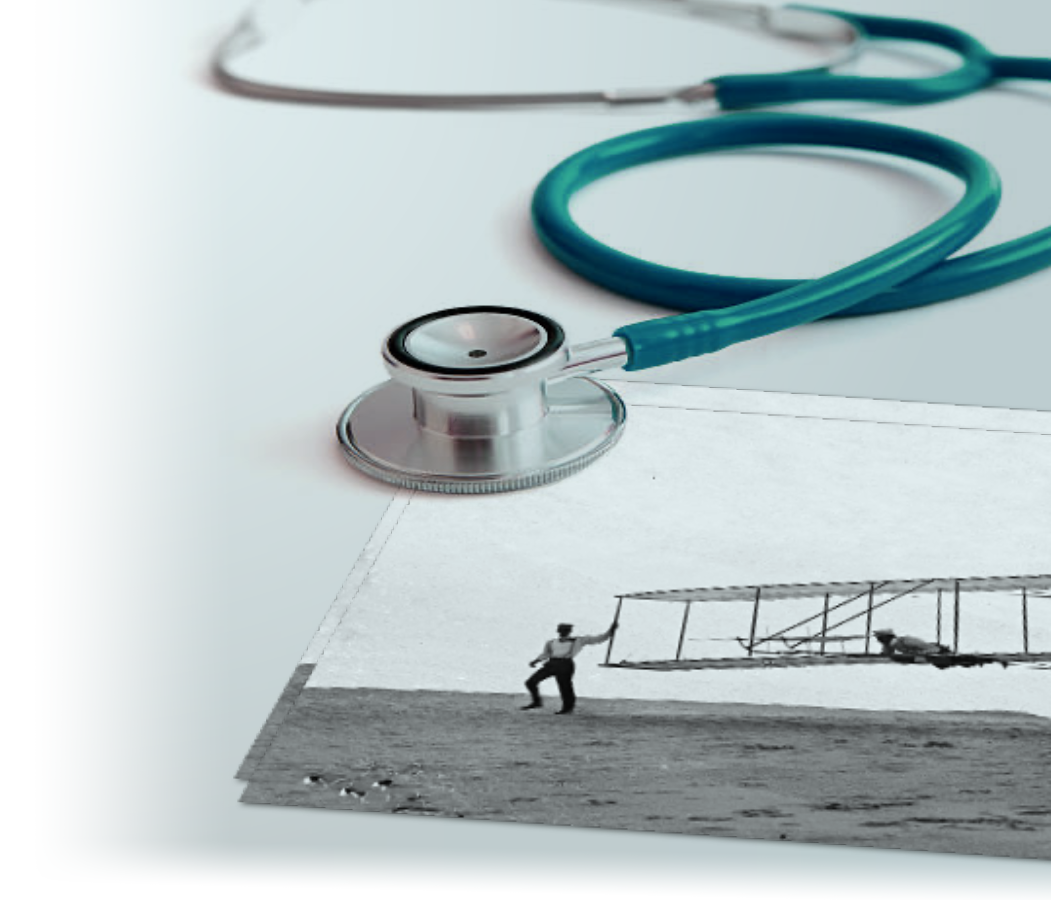A Look at the History of Our Organization
The Montgomery County Medical Society was founded in 1849, although the first physician came to Dayton in 1788. Dr. Jonathan Hole, who is thought to have been a descendent of Alfred the Great of England, was the first physician in Cincinnati and travelled to Dayton on his rounds before settling here in the late 1790s. He was born in New Jersey in 1755. He was sent to the University of Berlin by the family physician who apparently adopted him as a foster child.
Dr. Jonathon Hole’s Contributions in Montgomery County
In 1775 Dr. Hole returned to become a physician in the colonial militia. He was present at the battle of Bunker Hill and later served under General Montgomery in the Canadian campaign along with Aaron Burr and Benedict Arnold. Dr. Hole was released from service in 1776 because of failing health. He married a woman who was a cousin of Israel Ludlow and a relative of Daniel cooper. Because of them, he then came to Losantiville (today called Cincinnati) and later to Centerville. He purchased land in both places from his awards under the G.I. bill of that time. Our County was named for General Montgomery at Dr. Hole’s suggestion. Ludlow and Cooper are also familiar names to Daytonians.
Smallpox Epidemic
Dr. Hole helped control the smallpox epidemic in Cincinnati in 1792-93 by introducing cow-pox inoculation. This was four years before Edward Jenner’s experiments in developing a smallpox vaccine. This occurred during George Washington’s first presidential term.
Hole’s Creek
Dr. Hole built a cabin on Silver Creek, now called Hole’s Creek. His brothers moved to Hole’s Station, now called Miamisburg, and to Preble and Darke Counties. His spring house is still standing on Mad River Road.
Early Diseases Treated
Dr. Hole was the only doctor in Montgomery County during the county’s first five years. Diseases included Ague, Fever, and Milk Sickness. Children died frequently from milk contaminated with tuberculosis, other bacteria, or toxic plants eaten by cows.
He practiced modern medicine for the time, including charm cures, purging, cupping and leeches. Common medicines included calomel, ipecac, and quinine. His practice on the frontier extended from Hamilton in the south to Sidney in the North, Springfield in the east and west to Indiana. It included riding horseback day and night to visit a patient; camping out overnight; fighting wild animals, Native Americans, and inclement weather.
Medical practice at that time was a poor and miserable business. One father advised his daughter to stop dating a young doctor because he could never support her. Fees for house calls were fifty cents, and these sometimes required a two-day journey. Frequently, bills were paid with other goods and services – such as a two-year old heifer, 200 bushels of corn, or a pair of shoes.
To supplement his income, D. Hole built a sawmill near the intersection of Mad River Road and Alexandersville-Bellbrook Road. Other physicians engaged in farming, lumbering, real estate, preaching and pharmacy.
Additional Roles of Early Physicians
Although these early physicians worked part time, they also found time as church officers, were learned in books, established schools, held government offices, and fought in all the wars.
One Dayton physician helped start the first incorporated library in Ohio in 1809.
Another physician served as the Mayor of Dayton in 1833. By 1812, the Ohio Legislature incorporated the Ohio State Medical Society and Dr. Jonathan Hole was one of the 120 new members. Dr. Hole died the following year in 1813 at the age of 57. An elementary school on Whipp Road is named for him with a monument provided by the Montgomery County Medical Society.
Creation of a Medical Society & Licensing
From 1813 to 1847, several unsuccessful attempts were made to form a lasting county medical society. Only a few doctors in the state were graduates of a regular medical college. Dr. Jonathan Steele, a noted Dayton name, was the first in 1812. There were, however, many faith healers, medicine men and numerous assorted healers of the sick. Apprenticeship by a young man to an older physician was very common.
After the 1812 law, a prospective doctor was required to take an oral examination to be licensed to practice. One candidate was asked how large his medical library was. He answered, “Sixty pounds”, and he brought the entire library to the exam in a gunny sack. He was denied a license but appealed to his congressman and was granted permission to practice. The only disadvantage to not having a license was the inability to collect a delinquent fee in court.
In 1847, the American Medical Association was formed in Philadelphia and planned to meet in Cincinnati in 1850. This spurred the local medical community in Dayton to form the Montgomery County Medical Society in 1849. At the time, Dayton had 10,000 people and there was a cholera epidemic.
The Early Days of the Montgomery Medical Society
Of the 41 doctors in the area, four refused to join the Society, four were suspended or expelled the first year, and one was refused membership.
The first President was Dr. Edwin Smith. His house at 131 West Third Street is still standing, the current home of the Dayton Bicycle Club.
The early meetings were mainly discussions of ethics and occasionally of disease. Ethics was very important. The privileges which society gave to educated professionals (physicians, lawyers, and ministers) required a high standard of duty in return.
In the 1850s, a Dayton physician headed the local branch of the underground railway and enabled slaves to reach Canada.
In 1851, a fee list was adopted, which included:
- First visit in the city – $1.00
- Subsequent visits – $.75
- Travelling: 1st mile: $1.00; each additional: $.25 – $.50
- Detention with a patient: $.50 per hour; overnight: $5.00; uncomplicated delivery: $5.00
There was a penalty of $50.00 for reducing fees “except where charity or some equally honorable motive may induce a departure therefrom.”
Today, any discussion of fees by a group of doctors is illegal according to the FTC. The creation of standard fees, either ceilings, or floors, can be legally accomplished now only by insurance companies and the government.
Suspension or expulsion of the members of the fledgling Montgomery County Medical Society was common during the early years. One physician was expelled for consulting with what was at that time considered a quack. He sued the Society, and the membership was assessed to pay the legal costs. Most refused, and the President had to pay the costs out of his own pocket. No expulsions were made for at least forty years following.
The first Code of Ethics of the AMA was adopted in 1853.
In 1856, hypodermic syringes came into use.
In 1868, a Board of Health was established, and physicians served without pay. The board recommended the first sewers. Dayton population was then 30,000.
Thermometers came into use.
In 1870, a paper was read before Montgomery County Medical Society entitled, “A Plea for State Medicine” – almost one hundred years before Medicare.
In 1887, the first appendectomy was reported.
In 1895, Diphtheria antitoxin was used within a few months of its discovery and manufacture. Because this case was reported in the newspaper, the physician was severely criticized for advertising.
Surgery grew. It was not uncommon for a surgeon to go out in the field at night and remove hairs from his horse’s tail to use as sutures in the operating room the next day.
In 1905, the Montgomery County Medical Society recommended a building code for the city. In 1907, the Medical Society began working for “certified” (i.e., pure) milk. Within one year of its availability, the infant death rate was cut in half. Free milk was provided for the indigent from money obtained from the proceeds of an annual baseball game between doctors and lawyers. The Tuberculosis Society was established. Volunteers served as school physicians and began providing well-baby exams. A public Health Education Committee was begun. In 1913, following The Great Flood, epidemics were expected because of the interruption of sewer and water service. Private practitioners, the U.S. Health Service and the local Board of Health all worked long hours without pay to help prevent any epidemic from occurring.
The same year, a State Industrial Compensation law was enacted to stem the tide of business bankruptcies from payments and lawsuits for industrial injuries. Most doctors opposed the law because of the fear it would be a forerunner of state medicine with much paperwork and low fees.
In the early 20th century, MCMS supported smoke inspections, food handler exams, meat inspections, an anti-goiter campaign and mental hygiene programs.
During the Depression, hospital clinics were established, and physicians provided free medical care to the indigent. The city’s bills, including medical care, were paid in local authorized script, instead of federal currency, which was scarce.
Group hospitalization plans started in 1935. By 1946, the premiums had risen to $.60 per month for an individual, $1.90 per month for a family. In 1936, a monthly bulletin, “Medical News”, was started by the Medical Society. Today, it is called “Dayton Medicine.”
The Medical Society Services Bureau was started to aid physicians in some of the business aspects of their practices. By 1949, there were 440 members. In 1952, the Medical Society started its telephone service so that patients could always find a doctor, their doctor, at any time of day or night. The first year showed 128,000 calls. In recent years, there were over 500,000 calls. Operation of this service was taken over in November 2019, as competitive systems entered the local community.
In the 1950s, the Montgomery County Medical Society created the Dayton Area Heart Association, and the Montgomery County Society for Cancer Control (later known as Dayton Area Cancer Association).
In 1954, Dr. Curtis Ginn, whose papers provided much of the history of the Montgomery County Medical Society, astutely wrote: “Many problems will face medicine in the coming century. Medicine, classed as a profession for hundreds of years, is facing a change. Owing to the advances in knowledge and the various aids to diagnosis and treatment, it is becoming a business. The art of practicing is being lost. With a small number of doctors in proportion to the population, the worldwide trend toward socialism, and the rapid and large increase in the cost of hospital and doctors’ bills, it is not improbable that some measure of regulation and limitation will be applied.”
In 1951, A Dayton newspaper reported on the extensive amount of free care that was given by Montgomery County Medical Society member physicians. This tradition has continued through the years, with Project Mend – providing free care to those who were affected by downturn of employment from General Motors in the early 1980s; Project OPEN – which waived fees that were not covered by Medicare for those who could not afford them; and MCMS was a founding partner in Reach Out of Montgomery County, providing care for the uninsured and underinsured.
In the 1960s, the Medical Society helped distribute Sabin oral polio vaccine. Support was given for measles immunization and fluoridation of water to reduce dental decay. The Community Blood Bank was created. Cultural activities included a medical society orchestra and the first physician glee club in the United States.
Communication lines with the public were provided through a medical society sponsored “Call the Doctor” television program. This was followed by “Doctor on Line” on radio in 1998. One of the most successful programs was the “Mini-Internship” program through the 1980s which invited community leaders to learn about the art and science of medicine by accompanying physicians for a two-day period in both hospital and office settings.
In 1973, MCMS supported efforts to develop the Wright State University School of Medicine – a community based institution with local physicians participating as volunteer faculty at all the local hospitals.
MCMS physician members contributed to the community in a material way, having been recognized four times in the 1980s for being #1 in the entire country in the area of physician giving to the United Way!
(This article was presented by Alan H. Klein, MD, 1990 President of MCMS, upon the recognition of being honored by the Newcomen Society)
 menuMenu
searchSearch
menuMenu
searchSearch





